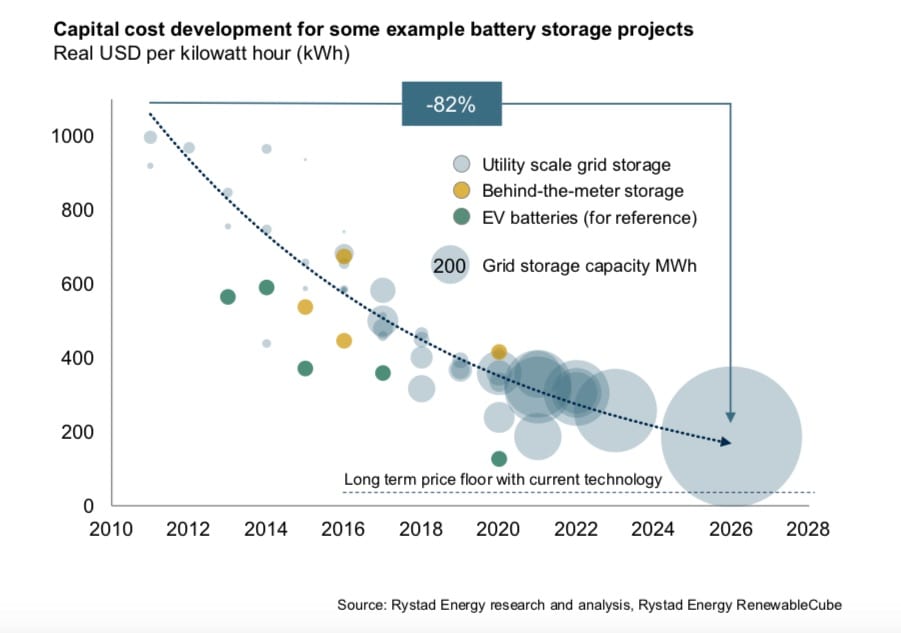Hydrogen has the potential to help bring more than half of the world’s emissions down to zero, but to reach that potential it requires aggressive government support, a dramatically improved value chain – and it needs batteries to fail.
That last point is one of the most striking findings in a new series of reports by Norwegian energy research house Rystad Energy, the last of which, on the “battery society”, was released last week.
The reports examine three solutions to the problem of storage in an energy system dominated by wind and solar: carbon capture and storage, hydrogen and batteries.
They conclude that battery technology is the most powerful of the three, having the potential to help reduce to zero 78 per cent of the world’s emissions. CCS could potentially help reduce 62 per cent of the world’s emissions, though it is the least practical of the three.
Hydrogen could help reduce 51 per cent of the world’s emissions, but to reach that level it would need to be used in areas where batteries currently have a big edge, such as electric vehicles and electricity grid support.
The race between hydrogen and battery technology is the latter’s to lose, the report argues. Batteries are not especially reliant on either dramatic policy changes, such as aggressive carbon pricing; or on rapid development in the value chain.
“An important advantage of the Battery Society is the fact that battery manufacturers must only rely on themselves to ramp up battery supply and bring the Battery Society to fruition,” the report says. “The CCS and Hydrogen Societies, on the other hand, are dependent on policy changes and cost developments in other parts of the value chain.
“In order to succeed, they essentially need batteries to fail,” it concludes.
 If batteries succeed in living up to their promise, Rystad finds hydrogen will be a fairly niche product used mainly in areas like steelmaking, shipping and long-haul aviation.
If batteries succeed in living up to their promise, Rystad finds hydrogen will be a fairly niche product used mainly in areas like steelmaking, shipping and long-haul aviation.
Rystad is particularly bullish on the role of batteries in electricity networks.
“If battery costs continue to decline at current rates, they will comprise an increasing share of the power market and can, together with cheap renewables, potentially displace a significant portion of the current fossil fuel baseload generation.
“This development will also provide cheap batteries for other parts of the energy system, including distributed and behind-the-meter batteries in buildings, as well as support the rapid electrification of the transportation sector.”
If there is any role for hydrogen in powering grids, Rystad says it will depend how much can first be covered by lithium-ion batteries. Using hydrogen to power electricity grid is a convoluted process.
It requires electricity to be used to make hydrogen through electrolysis, after which that hydrogen is stored, and then turned it back into electricity – a process that is costly and inefficient. In an interview with the Financial Times this week, Thomas Koch Blank, senior principal at think tank Rocky Mountain Institute, described this method as “really dumb” because of the energy that is wasted.
In a world where renewable energy capacity was massively overbuilt, this inefficiency may not matter too much. But the sheer amount of electricity needed to make create a “hydrogen society” illustrates the challenge. Rystad estimates it would take 18,000 terawatt hours of electricity to make enough green hydrogen to meet its “hydrogen society” scenario. That’s 75 per cent of current global electricity demand.
Rystad says to manufacture that amount of hydrogen, blue hydrogen production – which creates hydrogen from methane, and stores the CO2 emissions – would be required along with green hydrogen production. But it says that process cannot be completely emissions-free, a position backed by a recent paper published by the Australian National University.
Rystad’s study came the same week Toyota announced it was bringing its latest hydrogen fuel cell car, the second generation Mirai, to Australia in April – a somewhat perplexing move, given few experts seems to think hydrogen fuel cell vehicles stand a chance against battery EVs (BEVs) without very aggressive government backing. Toyota has opened a tiny green hydrogen plant and refuelling station in Melbourne, partly funded by the Australian Renewable Energy Agency.
Rystad concludes that hydrogen fuel cell vehicles (FCEVs) stant little chance against BEVs. However, it says FCEVs “may be able to establish market share in some niche markets or geographies, as some countries still push policies dedicated to FCEVs”.
The report comes amid an explosion of interest in green hydrogen manufacturing in Australia, with iron ore magnate Andrew Forrest at the vanguard and with the intellectual backing of former chief scientist Alan Finkel and economist Ross Garnaut, among others.
Green hydrogen’s growing reputation as the silver bullet to the challenge of decarbonisation has been heavily scrutinised over the last 12 months, including in a major report by Bloomberg New Energy Finance, a long study by UK news website Carbon Brief, and an ongoing series in the Financial Times.







